Abstract
Treatment with a preparation of monophosphoryl lipid A, known to be capable of abolishing the expression of CD8+ suppressor T cell activity generated during the antibody response to type III pneumococcal polysaccharide (SSS-III), was found to have no adverse effect upon either induction or expression of CD8+ cytotoxic T lymphocyte activity specific for influenza A virus antigens. This suggests that suppressor T cells and cytotoxic T lymphocytes represent functionally distinct subsets of CD8+ T cells which can be differentiated on the basis of their sensitivities to inactivation by monophosphoryl lipid A.
Full text
PDF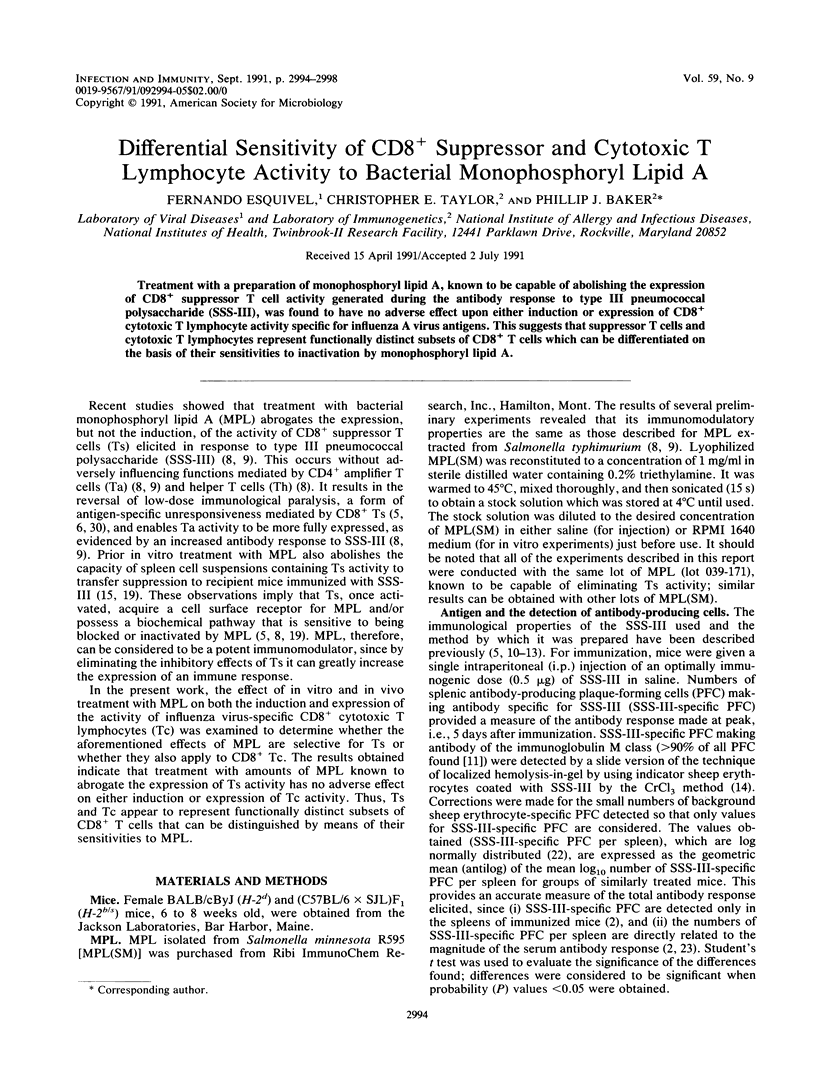
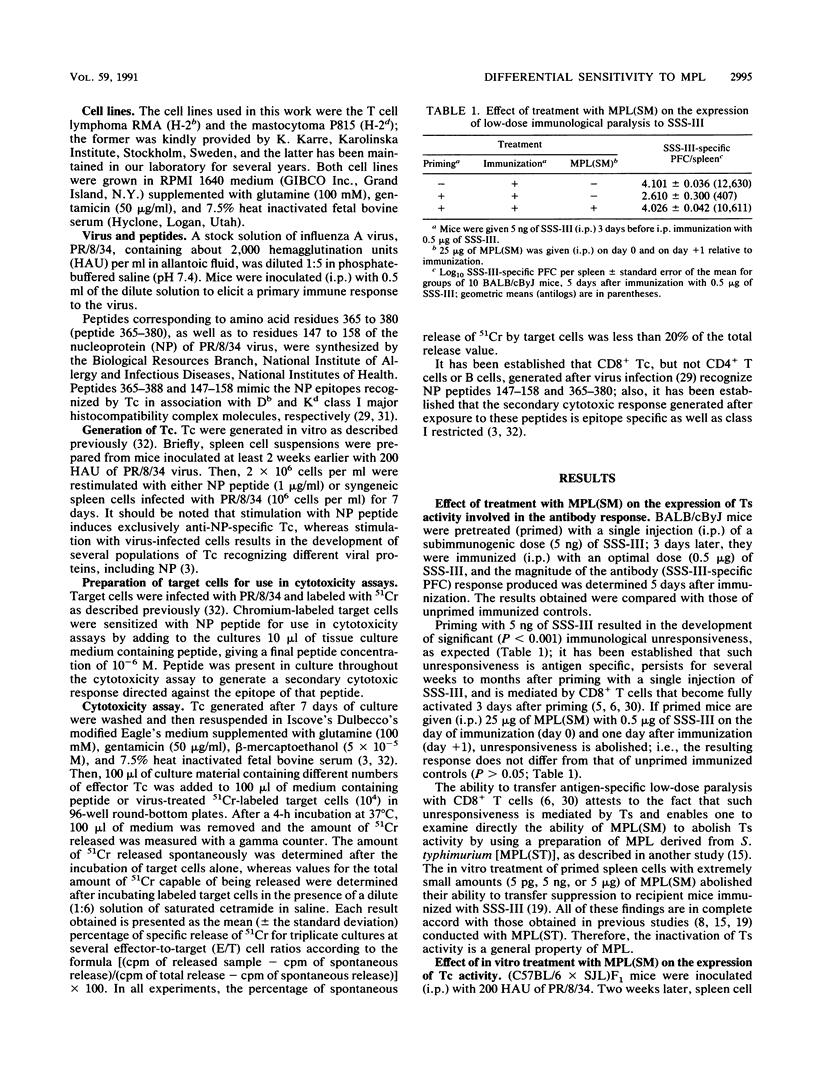
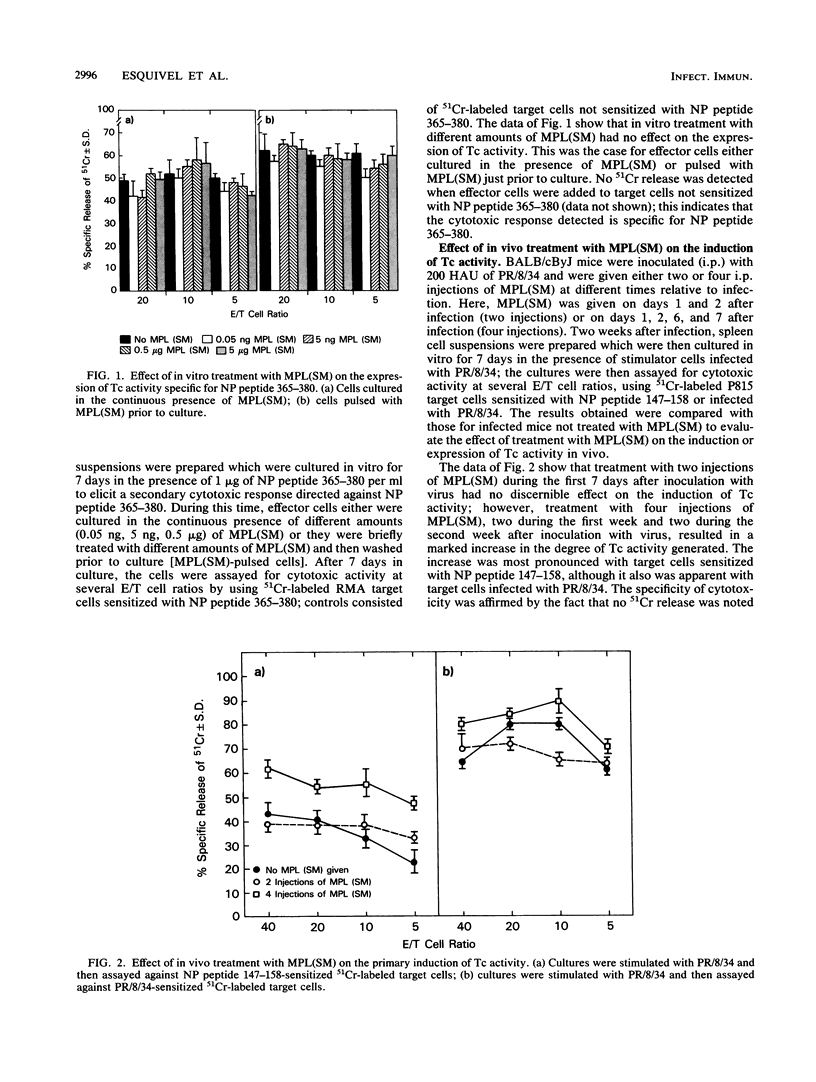
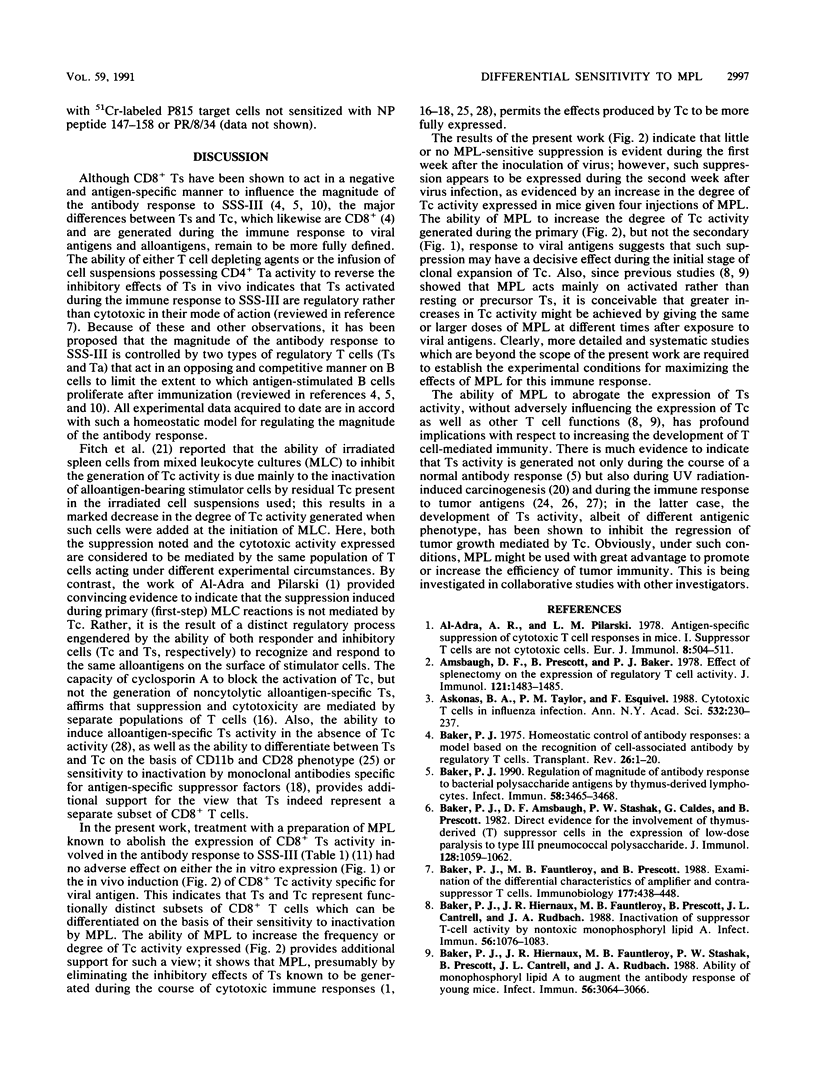
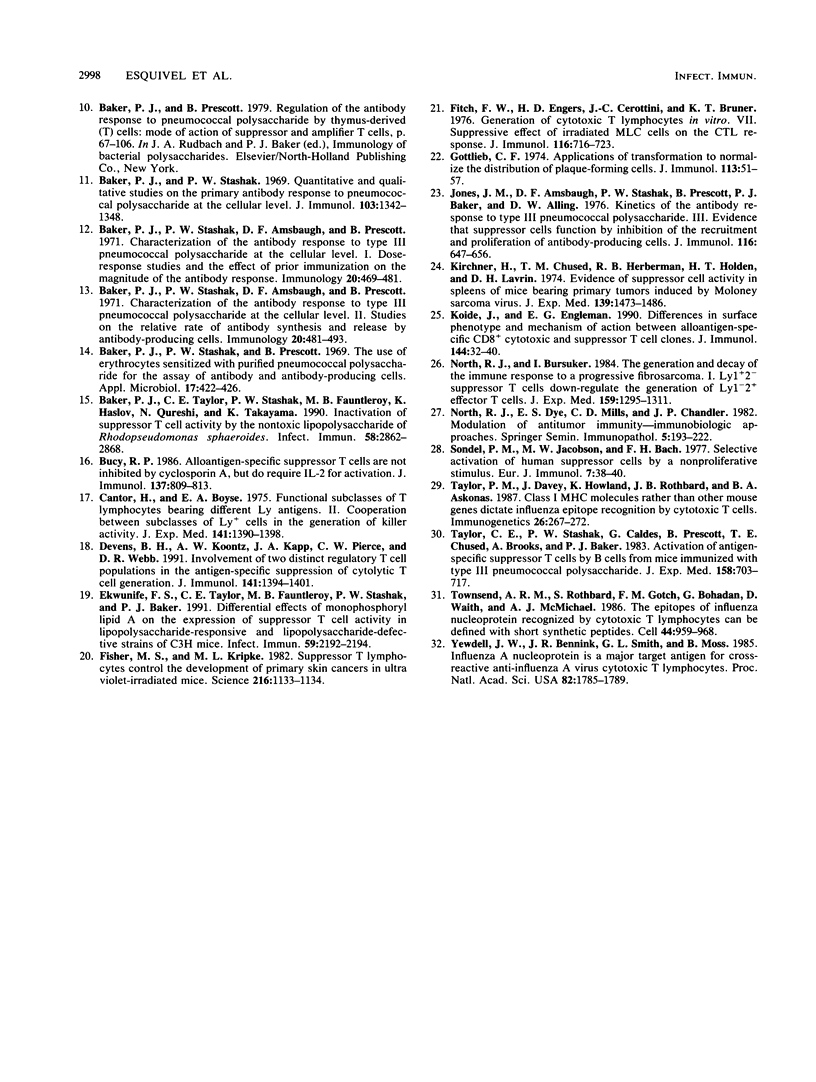
Selected References
These references are in PubMed. This may not be the complete list of references from this article.
- Al-Adra A. R., Pilarski L. M. Antigen-specific suppression of cytotoxic T cell responses in mice. I. Suppressor T cells are not cytotoxic cells. Eur J Immunol. 1978 Jul;8(7):504–511. doi: 10.1002/eji.1830080710. [DOI] [PubMed] [Google Scholar]
- Amsbaugh D. F., Prescott B., Baker P. J. Effect of splenectomy on the expression of regulatory T cell activity. J Immunol. 1978 Oct;121(4):1483–1485. [PubMed] [Google Scholar]
- Askonas B. A., Taylor P. M., Esquivel F. Cytotoxic T cells in influenza infection. Ann N Y Acad Sci. 1988;532:230–237. doi: 10.1111/j.1749-6632.1988.tb36342.x. [DOI] [PubMed] [Google Scholar]
- Baker P. H., Stashak P. W. Quantitative and qualitative studies on the primary antibody response to pneumococcal polysaccharides at ehe cellular level. J Immunol. 1969 Dec;103(6):1342–1348. [PubMed] [Google Scholar]
- Baker P. J., Amsbaugh D. F., Stashak P. W., Caldes G., Prescott B. Direct evidence for the involvement of T suppressor cells in the expression of low-dose paralysis to type III pneumococcal polysaccharide. J Immunol. 1982 Mar;128(3):1059–1062. [PubMed] [Google Scholar]
- Baker P. J., Fauntleroy M. B., Prescott B. Examination of the differential characteristics of amplifier and contrasuppressor T cells. Immunobiology. 1988 Sep;177(4-5):438–448. doi: 10.1016/S0171-2985(88)80010-X. [DOI] [PubMed] [Google Scholar]
- Baker P. J., Hiernaux J. R., Fauntleroy M. B., Prescott B., Cantrell J. L., Rudbach J. A. Inactivation of suppressor T-cell activity by nontoxic monophosphoryl lipid A. Infect Immun. 1988 May;56(5):1076–1083. doi: 10.1128/iai.56.5.1076-1083.1988. [DOI] [PMC free article] [PubMed] [Google Scholar]
- Baker P. J., Hiernaux J. R., Fauntleroy M. B., Stashak P. W., Prescott B., Cantrell J. L., Rudbach J. A. Ability of monophosphoryl lipid A to augment the antibody response of young mice. Infect Immun. 1988 Dec;56(12):3064–3066. doi: 10.1128/iai.56.12.3064-3066.1988. [DOI] [PMC free article] [PubMed] [Google Scholar]
- Baker P. J. Homeostatic control of antibody responses: a model based on the recognition of cell-associated antibody by regulatory T cells. Transplant Rev. 1975;26:3–20. doi: 10.1111/j.1600-065x.1975.tb00172.x. [DOI] [PubMed] [Google Scholar]
- Baker P. J. Regulation of magnitude of antibody response to bacterial polysaccharide antigens by thymus-derived lymphocytes. Infect Immun. 1990 Nov;58(11):3465–3468. doi: 10.1128/iai.58.11.3465-3468.1990. [DOI] [PMC free article] [PubMed] [Google Scholar]
- Baker P. J., Stashak P. W., Amsbaugh D. F., Prescott B. Characterization of the antibody response to type 3 pneumococcal polysaccharide at the cellular level. I. Dose-response studies and the effect of prior immunization on the magnitude of the antibody response. Immunology. 1971 Apr;20(4):469–480. [PMC free article] [PubMed] [Google Scholar]
- Baker P. J., Stashak P. W., Amsbaugh D. F., Prescott B. Characterization of the antibody response to type 3 pneumococcal polysaccharide at the cellular level. II. Studies on the relative rate of antibody synthesis and release by antibody-producing cells. Immunology. 1971 Apr;20(4):481–492. [PMC free article] [PubMed] [Google Scholar]
- Baker P. J., Stashak P. W., Prescott B. Use of erythrocytes sensitized with purified pneumococcal polysaccharides for the assay of antibody and antibody-producing cells. Appl Microbiol. 1969 Mar;17(3):422–426. doi: 10.1128/am.17.3.422-426.1969. [DOI] [PMC free article] [PubMed] [Google Scholar]
- Baker P. J., Taylor C. E., Stashak P. W., Fauntleroy M. B., Hasløv K., Qureshi N., Takayama K. Inactivation of suppressor T cell activity by the nontoxic lipopolysaccharide of Rhodopseudomonas sphaeroides. Infect Immun. 1990 Sep;58(9):2862–2868. doi: 10.1128/iai.58.9.2862-2868.1990. [DOI] [PMC free article] [PubMed] [Google Scholar]
- Bucy R. P. Alloantigen-specific suppressor T cells are not inhibited by cyclosporin A, but do require IL 2 for activation. J Immunol. 1986 Aug 1;137(3):809–813. [PubMed] [Google Scholar]
- Cantor H., Boyse E. A. Functional subclasses of T lymphocytes bearing different Ly antigens. II. Cooperation between subclasses of Ly+ cells in the generation of killer activity. J Exp Med. 1975 Jun 1;141(6):1390–1399. doi: 10.1084/jem.141.6.1390. [DOI] [PMC free article] [PubMed] [Google Scholar]
- Devens B. H., Koontz A. W., Kapp J. A., Pierce C. W., Webb D. R. Involvement of two distinct regulatory T cell populations in the antigen-specific suppression of cytolytic T cell generation. J Immunol. 1991 Mar 1;146(5):1394–1401. [PubMed] [Google Scholar]
- Ekwunife F. S., Taylor C. E., Fauntleroy M. B., Stashak P. W., Baker P. J. Differential effects of monophosphoryl lipid A on expression of suppressor T cell activity in lipopolysaccharide-responsive and lipopolysaccharide-defective strains of C3H mice. Infect Immun. 1991 Jun;59(6):2192–2194. doi: 10.1128/iai.59.6.2192-2194.1991. [DOI] [PMC free article] [PubMed] [Google Scholar]
- Fisher M. S., Kripke M. L. Suppressor T lymphocytes control the development of primary skin cancers in ultraviolet-irradiated mice. Science. 1982 Jun 4;216(4550):1133–1134. doi: 10.1126/science.6210958. [DOI] [PubMed] [Google Scholar]
- Fitch F. W., Engers H. D., Cerottini J. C., Bruner K. T. Generation of cytotoxic T lymphocytes in vitro. VII. Suppressive effect of irradiated MLC cells on CTL response. J Immunol. 1976 Mar;116(3):716–723. [PubMed] [Google Scholar]
- Gottlieb C. F. Application of transformations to normalize the distribution of plaque-forming cells. J Immunol. 1974 Jul;113(1):51–57. [PubMed] [Google Scholar]
- Jones J. M., Amsbaugh D. F., Stashak P. W., Prescott B., Baker P. J., Alling D. W. Kinetics of the antibody response to type III pneumococcal polysaccharide. I. Evidence that suppressor cells function by inhibiting the recruitment and proliferation of antibody-producing cells. J Immunol. 1976 Mar;116(3):647–656. [PubMed] [Google Scholar]
- Kirchner H., Chused T. M., Herberman R. B., Holden H. T., Lavrin D. H. Evidence of suppressor cell activity in spleens of mice bearing primary tumors induced by Moloney sarcoma virus. J Exp Med. 1974 Jun 1;139(6):1473–1487. doi: 10.1084/jem.139.6.1473. [DOI] [PMC free article] [PubMed] [Google Scholar]
- Koide J., Engleman E. G. Differences in surface phenotype and mechanism of action between alloantigen-specific CD8+ cytotoxic and suppressor T cell clones. J Immunol. 1990 Jan 1;144(1):32–40. [PubMed] [Google Scholar]
- North R. J., Bursuker I. Generation and decay of the immune response to a progressive fibrosarcoma. I. Ly-1+2- suppressor T cells down-regulate the generation of Ly-1-2+ effector T cells. J Exp Med. 1984 May 1;159(5):1295–1311. doi: 10.1084/jem.159.5.1295. [DOI] [PMC free article] [PubMed] [Google Scholar]
- North R. J., Dye E. S., Mills C. D., Chandler J. P. Modulation of antitumor immunity--immunobiologic approaches. Springer Semin Immunopathol. 1982;5(2):193–220. doi: 10.1007/BF00199796. [DOI] [PubMed] [Google Scholar]
- Sondel P. M., Jacobson M. W., Bach F. H. Selective activation of human suppressor cells by a nonproliferative stimulus. Eur J Immunol. 1977 Jan;7(1):38–40. doi: 10.1002/eji.1830070109. [DOI] [PubMed] [Google Scholar]
- Taylor C. E., Stashak P. W., Caldes G., Prescott B., Chused T. E., Brooks A., Baker P. J. Activation of antigen-specific suppressor T cells by B cells from mice immunized with type III pneumococcal polysaccharide. J Exp Med. 1983 Sep 1;158(3):703–717. doi: 10.1084/jem.158.3.703. [DOI] [PMC free article] [PubMed] [Google Scholar]
- Taylor P. M., Davey J., Howland K., Rothbard J. B., Askonas B. A. Class I MHC molecules rather than other mouse genes dictate influenza epitope recognition by cytotoxic T cells. Immunogenetics. 1987;26(4-5):267–272. doi: 10.1007/BF00346521. [DOI] [PubMed] [Google Scholar]
- Townsend A. R., Rothbard J., Gotch F. M., Bahadur G., Wraith D., McMichael A. J. The epitopes of influenza nucleoprotein recognized by cytotoxic T lymphocytes can be defined with short synthetic peptides. Cell. 1986 Mar 28;44(6):959–968. doi: 10.1016/0092-8674(86)90019-x. [DOI] [PubMed] [Google Scholar]
- Yewdell J. W., Bennink J. R., Smith G. L., Moss B. Influenza A virus nucleoprotein is a major target antigen for cross-reactive anti-influenza A virus cytotoxic T lymphocytes. Proc Natl Acad Sci U S A. 1985 Mar;82(6):1785–1789. doi: 10.1073/pnas.82.6.1785. [DOI] [PMC free article] [PubMed] [Google Scholar]


